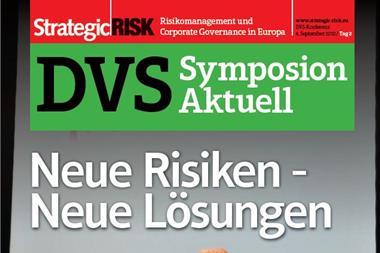Speaking in an interview with StrategicRISK, DVS chairman Klaus Greimel said he feared that a shortage of young, educated professionals entering the profession threatened the development of the sector

What are the biggest problems facing risk managers in Germany?
KG: As an exporting nation, one of the real major risks is supply chain. From an exporter perspective this is a really crucial risk. Last year’s flooding in Thailand made it very clear how rapidly the risk situation can change, and also how exposed some companies are to potential risks they had never realised they would be exposed to.
There are obviously a range of other issues upon which risk managers in Germany need to focus – such as cyber – but what is perhaps most important of all is that we have a higher transparency relating to the risks we have at home. Only by doing this will insurers be able to get the type of answers from us that will help them feel more comfortable about risks and enable them to not have to work blindly.
How much of a threat is the euro zone economy?
KG: From an export perspective, general economic issues in the euro zone and around the world have to be a concern. For industry in Germany, however, the indication appears to be that if we can remain at current levels then our economy will stay in positive territory. Unfortunately, you cannot be so enthusiastic about issues abroad. As such, Germany is currently doing quite well, but there have to be question marks about what happens elsewhere.
I am an optimistic person and I believe that a global economic recovery represents a great opportunity for Germany and will give Germany the chance to grow with the international economy once more.
How should risk managers and the insurance industry adapt to deal with those risks?
KG: In terms of supply chain risk, there are quite good internal regulations in force which have been introduced over the past five or 10 years. This has changed the way risk is managed for the better with much more transparency resulting in genuine awareness at board or supervisory board level.
Greater internal risk transparency has seen important changes for companies both from the bottom up and the top down. Boards realise that risk is important for companies and they understand there is a chance to use internal awareness of risk to strengthen their business position.
It is also important to not only identify risk, but also to quantify risks. Often you know there is a risk and the quality of that risk – but you should not always trust the Monte Carlo simulation models 100% and take their indications for granted.
We need to look to more sophisticated ways to get a better understanding of potential risks, but the tools for doing this are not yet that advanced. This needs to be addressed urgently. If the modelling is not right then risk managers and insurers cannot fully compute absolute levels of risk and, as a result, cannot offer the right levels of protection to satisfy the needs of businesses.
This is something which I am concerned about and is an area that needs to change.
You have now been chairman of DVS for more than a year, what changes have you made?
KG: We made a few internal changes but this was nothing to do with the way DVS had been run previously, more a case of being the right time for change.
Externally, we have been working hard on identifying issues in the insurance and risk markets and to try to improve these sectors for new developments and also to push more innovation. We have not spent too much time so far looking at education, but we will be focusing on this shortly so we can help bring forward risk managers and risk management as a profession. We also want to get closer to risk managers and share knowledge and experience so we can identify the most important issues we can then discuss with insurers.
How difficult do the next 12 months appear for risk managers? Are there emerging risks or trends which they need to look out for?
KG: Not specifically the next 12 months, but we are realising more and more as a profession that there is a lack of new and younger people coming into the risk management and insurance community.
There is currently a large number of high-ranking vacancies for risk managers and also on the insurance side and this is a problem we fear could worsen over the next five to 10 years. To try to counter this we are now working to attract more people from university. We have made some strides in terms of achieving this, but we need to speed up the process as we need more younger people to help us bring innovative ideas into risk management and the insurance sectors.
In terms of insurance, looking at whether premium levels will increase is always an indicator as to whether or not the market is going up. There is no signal so far about whether the market will increase overall, although there are certainly market segments where insurers might be looking for more of a premium for providing cover. Equally, there might be other insurers who will look to reduce premium levels in certain sectors. I cannot see general premium rates changing much as things are not currently dramatic enough to justify that – although I know some insurers would no doubt like to see rates rise!
What can delegates look forward to at this year’s DVS conference?
KG: We want to offer a wide spread of ideas and items for DVS delegates to discuss. If you look at the conference workshops they cover most of the main issues in the insurance and risk markets and we offer it this way so that delegates can get more information on those areas and take part in discussions which are most important to them.
These have always been well received when we have done them in the past and this is because they are not theoretical but are based on real-life practical issues.




















No comments yet